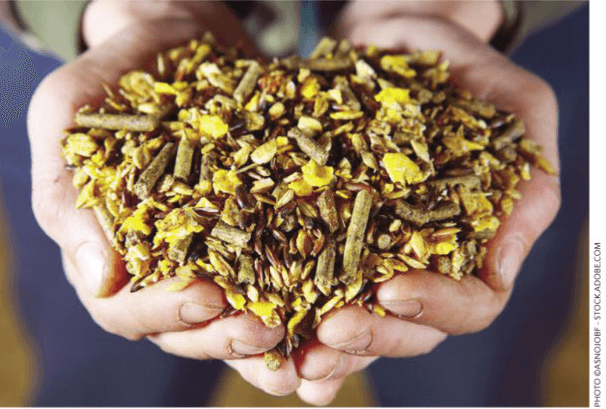Beware of this Marketing Ploy
By Eleanor M. Kellon, VMD, for the ECIR Group
 The “whole food” claim is being used to market some horse feeds and supplements. But what is a whole food, and are these products really superior?
The “whole food” claim is being used to market some horse feeds and supplements. But what is a whole food, and are these products really superior?
The term “whole food” is not currently regulated, so it can mean anything the company using it wants it to mean. Whole food was originally coined in the 1940s and referred to food “without subtraction, addition or alteration”, harvested and eaten fresh, and raised without pesticides, herbicides or chemical fertilizers. In other words, both unprocessed and organic.
Whole food in horse products is definitely not the same as organic. If you don’t see the USDA seal of certification, it’s not organic. Non-GMO is not the same thing as organic either and no guarantee the product does not contain chemicals even far more dangerous than glyphosate.
Whole food is supposed to mean not processed in any way – like eating a fresh apple or peach. Reference might be made to minimum necessary processing. This should include things like peeling a banana to eat it, rinsing dirt off a carrot, or cracking open a nut.
However, in one prominent feed that plays the whole-food card, the only actual whole food in it is oats. Everything else has been ground, skinned, pelletized, dried, heat-dehydrated (and possibly preserved with sulfur dioxide), dehulled, cleaned, exposed to strong magnetic fields, steamed (split peas), polished, or solvent extracted.
The reality is that very few whole foods will escape rotting inside a feed bag without processing or preservatives. Even drying and grinding leads to loss of some vitamins and fragile fatty acids. What starts out as a whole food loses some critical portions of its nutrition by the time it goes into a bag and really isn’t a whole food any longer.
Whole food supplements have another problem. In addition to not really being whole foods after they are processed into a powder or bar, the levels of nutrients they provide falls far short of being helpful. For example, one “multi” type whole food supplement made from fruits, vegetables, nuts (and some most definitely not whole foods like oils, bran, and processed yeast) provides the following amounts of nutrients per daily serving:
- Protein: 6.2 grams versus requirement of 630 grams (500 kg horse at maintenance)
- Calcium: 0.8 grams versus requirement of 20 grams
- Copper: 0.4 mg versus requirement of 100 mg
- Zinc: 1.35 mg versus requirement of 450 mg
Those are just the rock bottom, bare minimum requirements in health. Actual optimal requirements can be much higher.
Are these numbers misleading because nutrients in foods are much more bioavailable? No. That’s a myth. In fact, research has shown that minerals in foods are far less bioavailable than minerals in supplements, including inorganic minerals from rock.
There’s nothing wrong with the ingredients that go into these feeds and supplements, but the suggestion they are superior to other products does not stand up to scrutiny. For example, I would much rather feed processed wheat bran with its high protein, minerals and vitamin-packed wheat germ intact than whole wheat grain which is loaded with high glycemic index starch/flour. The whole food products have nice ingredients and are yummy, but they’re no substitute for verified nutritional supplements.
As much as I favor whole foods like whole oats, it’s not the answer to optimal nutrition for the management scenario of today’s domesticated horse.
About ECIR Group Inc.
Started in 1999, the ECIR Group is the largest field-trial database for PPID and EMS in the world and provides the latest research, diagnosis, and treatment information, in addition to dietary recommendations for horses with these conditions. Even universities do not and cannot compile and follow long term as many in-depth case histories of PPID/EMS horses as the ECIR Group.
In 2013 the Equine Cushing’s and Insulin Resistance Group Inc., an Arizona nonprofit corporation, was approved as a 501(c)3 public charity. Tax deductible contributions and grants support ongoing research, education, and awareness of Equine Cushing’s Disease/PPID and EMS.
THE MISSION of the ECIR Group Inc. is to improve the welfare of equines with metabolic disorders via a unique interface between basic research and real-life clinical experience. Prevention of laminitis is the ultimate goal. The ECIR Group serves the scientific community, practicing clinicians, and owners by focusing on investigations most likely to quickly, immediately, and significantly benefit the welfare of the horse.

The Northwest Horse Source is an independently owned and operated print and online magazine for horse owners and enthusiasts of all breeds and disciplines in the Pacific Northwest. Our contemporary editorial columns are predominantly written by experts in the region, covering the care, training, keeping and enjoyment of horses, with an eye to the specific concerns in our region.





